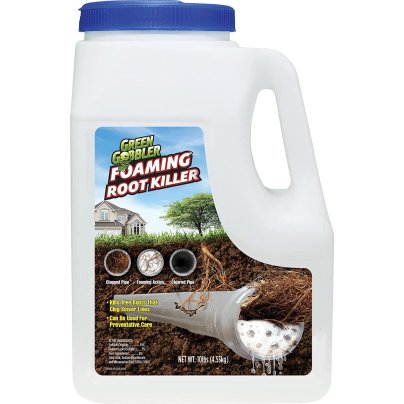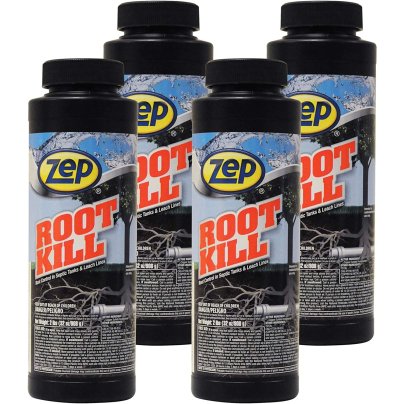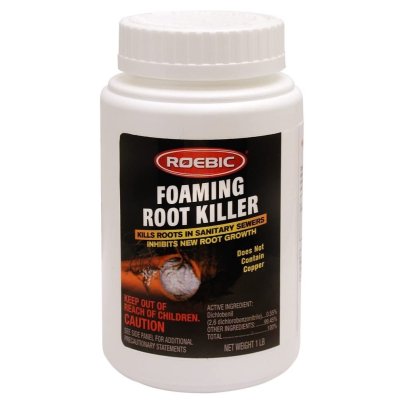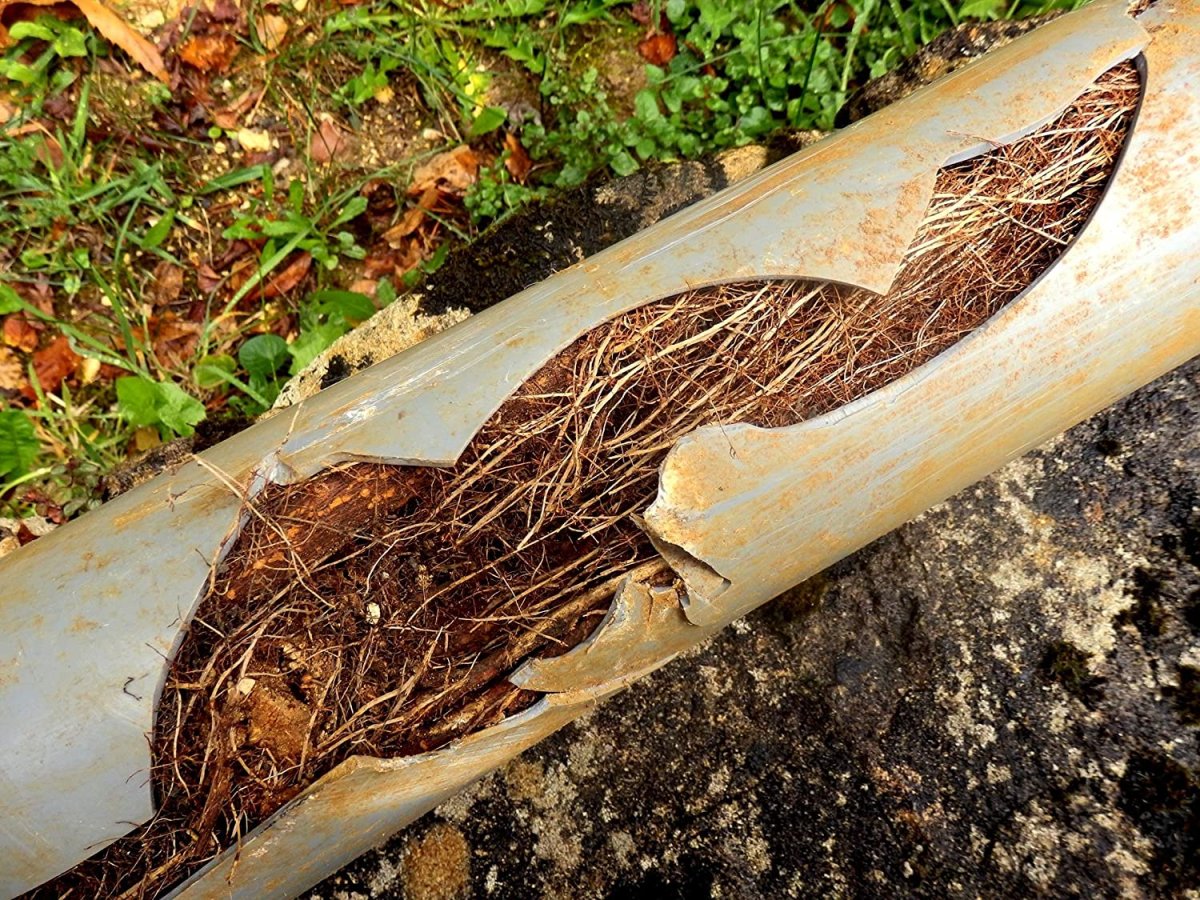
We may earn revenue from the products available on this page and participate in affiliate programs. Learn More ›
Slowly draining bathtubs and sinks, gurgling noises coming from the drain, toilets that regularly back up—though these could be run-of-the-mill clogs, they might also have something to do with those large trees in your backyard. As trees grow, so do their root systems. Over time, those roots can burrow into a home’s main drainage pipe, eventually causing a blockage. If caught early enough, an inexpensive root killer could solve the problem, saving homeowners a pricey call to a plumber.
Root killers consist of chemicals that are applied by simply flushing them down the toilet. Once the chemicals find their way to the offending tree roots, they latch on and kill them without harming the rest of the tree. Over a period of days or weeks, the problem roots rot and wither away, opening the drain. While some of these products rely on harsh chemicals, others use basic ingredients found in most kitchens. Ahead, learn more about what to look for in these drain-clearing products and find out which are the best root killers on the market.
- BEST OVERALL: Green Gobbler Foaming Root Killer
- BEST BANG FOR THE BUCK: Zep Root Kill
- BEST FOAMING: Roebic Foaming Root Killer
- BEST HEAVY-DUTY: RootX Root Intrusion Solution Kit
- ALSO CONSIDER: Sanco Industries Root Destroyer
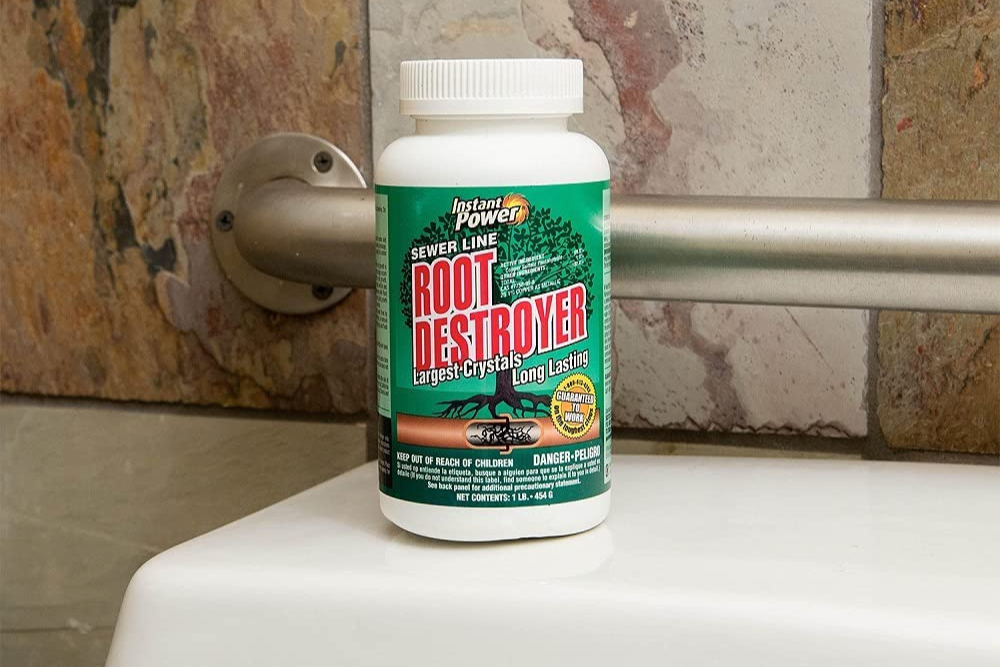
Before Buying a Root Killer for Sewer Lines
Root killers often contain chemicals that can be harmful to the environment. With that in mind, before deciding to use a root killer to banish tree roots blocking drainpipes, first consider nonchemical solutions to this problem.
- Determine the “root” cause. It’s difficult to tell if tree roots are the culprit without digging up the pipes and examining them firsthand. However, there are signs to look for. If the homeowner has tried other clog-removal remedies that failed to work, then tree roots are likely to blame. Persistent foul odors emanating from the drain may also indicate that roots are trapping waste in the lines. And, obviously, if there is a sizable tree within 20 feet of the main sewer drain line, then it’s possible its roots are infringing on the sewer line.
- Hire a plumber: A pro can manually remove the roots that are wreaking havoc on the drain. Although this is a pricey solution, it may be the only option if the problem is severe.
- Rent a sewer snake: A plumber would likely employ a large sewer snake to remove offending tree roots. This motorized tool consists of a long steel cable with a blade at the end. When the motor is turned on, the cable moves through the pipe, chewing through blockages as it goes. While these machines are expensive, DIYers can rent a sewer snake from a local home improvement store for about $50 for half a day.
- Remove the tree: Although cutting away tree roots may temporarily fix the problem, roots could grow back, cutting off drainage lines again. If the tree is overgrown or nearing the end of its life, removing the tree entirely could solve the problem permanently.
- Replace the drain line: If the drain line is old and crumbling, it may make sense to replace it entirely. While doing so, the plumber may be able to reroute the new line to avoid any threatening tree roots.
What to Consider When Choosing the Best Root Killer for Sewer Lines
When shopping for a root killer, consider the best type for the job, how long it will take to work, and any safety issues that apply. Read on for this crucial info about the best root killers.
Type
Root killers are herbicides—chemicals that destroy plants or inhibit their growth. They are available in four different formula types: crystal, dust, liquid, or foam. Root killers can be used to destroy existing roots, or they can be applied twice a year as a preventive.
Copper sulfate, an herbicide found in many root-killing products, comes in crystal, dust, or liquid form. It has the ability to kill roots without taking down the entire tree. Unfortunately, copper sulfate works slowly, sometimes taking weeks to clear a clog. If overused, it also has the potential to corrode steel or galvanized pipe walls or even melt plastic pipes. More importantly, copper sulfate also poses a threat to the environment. It can neutralize nutrients and bacteria that aquatic life needs to live, damage crops, and even poison drinking water.
Dichlobenil has a foam formula that fills the pipe and then works to dissolve tree roots. This herbicide is far less toxic than copper sulfate—the Environmental Protection Agency classifies it as having a low toxicity. Plus, dichlobenil won’t harm trees and shrubs. Some foaming root killers don’t use dichlobenil, instead opting for eco-safe ingredients such as salt and sodium bicarbonate, or baking soda.
Time to Work
Unlike drain cleaners, which work in minutes to clear a clog, root killers don’t offer such immediate satisfaction. Foaming tree-root killer takes between 2 and 7 days to dissolve tree roots, depending on how thick the roots are. Copper sulfate can take from 3 to 4 weeks to clear tree roots, depending on the location of the blockage in the pipes as well as the severity of the blockage.
Safety
Proper safety precautions should be taken when using root killers, as these products typically include chemicals that are hazardous to humans. Both types of root killers can cause eye or skin irritation, so always wear gloves, long sleeves and pants, and eye protection when applying these products.
Copper sulfate fumes are also dangerous to breathe in, so care should be taken to avoid inhaling the fumes. Make sure to ventilate the area properly by opening a window or turning on a bathroom fan when applying this type of root killer. Though copper sulfate root killers are safe for pipes when used correctly, it must be used sparingly and according to product directions, as overuse can corrode metal pipes or potentially melt plastic polyvinyl chloride, or PVC, pipes.
All root killers are safe for use in septic systems, as they won’t harm the bacterial action in the tank. Some root killers can even be added directly to a septic system to kill off any roots that may be growing into it.
Our Top Picks
The root killers below include both foaming and copper sulfate products that are proven to work. These root killers are easy to apply and will typically clear a clogged line in a matter of days or weeks.
Best Overall
Green Gobbler Foaming Root Killer

Pros
Cons
Product Specs
- Type: Foam
- Size: 10 pounds
- Active ingredients: Salt and baking soda
A safe yet effective foaming formula, Green Gobbler Foaming Root Killer clings to roots and dehydrates them, killing them by depriving them of water. It relies on a mix of salt and baking soda, so it’s safe for the environment. Over the course of a few days, offending tree roots dry out, become brittle, and dissolve.
Applying the root killer is easy. Simply flush 2 pounds of Green Gobbler down the toilet during periods of low use. Once the lines are clear, this foaming root killer can be used as an effective preventive for regrowth by treating the pipes with it once every 2 months.
Get the Green Gobbler root killer for sewer lines on Amazon or at The Home Depot.
Best Bang for the Buck
Zep Root Kill
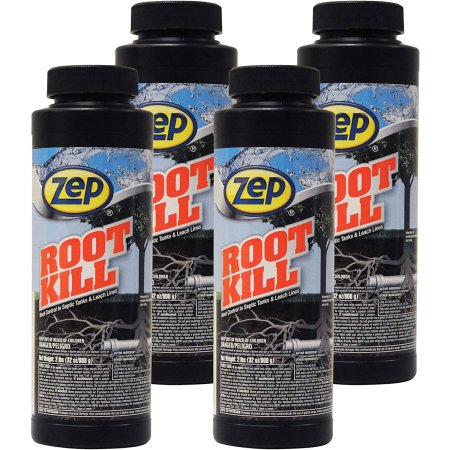
Pros
Cons
Product Specs
- Type: Crystals
- Size: 2 pounds
- Active ingredients: Copper sulfate
Those in need of a cheap fix to a clogged drain may consider this root killer from Zep. It costs less than other products and is easy to apply. Simply add granules to the toilet and flush. When the root killer comes into contact with roots or fungus, it kills them without harming the rest of the tree or any surrounding shrubs. It’s also safe for use with septic systems.
In addition to killing existing roots, Zep will also help prevent future growth of tree roots. Just keep in mind that copper sulfate is its active ingredient, so it should be used sparingly and only when needed to prevent damage to drainage lines.
Get the Zep root killer for sewer lines on Amazon or at The Home Depot.
Best Foaming
Roebic Foaming Root Killer

Pros
Cons
Product Specs
- Type: Foam
- Size: 1 pound
- Active ingredients: Dichlobenil
Roebic Foaming Root Killer uses a copper-free formula to kill roots and keep them from coming back. Once applied, Roebic root killer coats the entire pipe with foam to make full contact with roots. Its active ingredient, the herbicide dichlobenil, will also inhibit future root growth, preventing clogs from recurring.
To apply, dump the entire tub into the toilet and flush several times. Roebic root killer comes in 1-pound tubs, which is enough for a single treatment and is safe for all types of plumbing. It can also be applied twice a year as a preventive to keep root growth from returning. Though Roebic root killer is more effective than some other products, it’s also among the most expensive root killers on the market.
Get the Roebic root killer for sewer lines on Amazon or at The Home Depot.
Best Heavy-Duty
RootX Root Intrusion Solution Kit

Pros
Cons
Product Specs
- Type: Foam
- Size: 4 pounds
- Active ingredients: Dichlobenil
It may not come cheap, but for serious root problems, there are few better choices than RootX. When the dry powder components of RootX come into contact with water, they create a foam that fills the entire pipe, coating the pipe surfaces as well as any roots that might be blocking the way. In the process of killing roots, RootX also strips any grease or grime that has collected in the roots, ensuring nothing is left behind to clog the drain.
In addition to killing existing growth, RootX leaves a residual coating on the pipes above the water line that prevents new growth from taking hold for up to 12 months, which helps to justify its high price tag.
Get the RootX root killer for sewer lines on Amazon.
Also Consider
Sanco Industries Root Destroyer
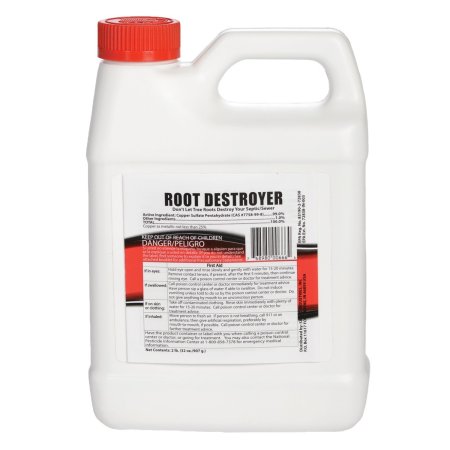
Pros
Cons
Product Specs
- Type: Crystals
- Size: 2 pounds
- Active ingredients: Copper sulfate
Sanco Industries Root Destroyer uses a high concentration of copper sulfate crystals to take down those roots growing into a main drainpipe. Application simply involves adding the product to the toilet closest to the main sewer line in half-pound increments and then flushing. Sanco Root Destroyer kills tree roots without harming the tree or any nearby shrubs.
Once roots absorb the copper sulfate—a process that typically takes 3 to 4 weeks—they’ll die, decay, and allow water to flow once again. The formula is also safe to use in septic systems, and it can be applied up to twice a year to prevent new growth from coming back.
Get the Sanco Industries root killer for sewer lines on Amazon.
Our Verdict
We chose Green Gobbler root killer for sewer lines as our Best Overall pick because it’s effective at killing existing roots and functions as an excellent preventive for future root growth—all while being safe for the environment. Those looking for an affordable fix for their clogged drains should consider Zep root killer for sewer lines, which is effective and easy to apply.
How to Make a DIY Root Killer for Sewer Lines
An effective root killer can actually be made using safe, common ingredients that most folks have at home, eliminating the need to purchase a root killer. To make foaming root killer, mix 1 cup each of vinegar, baking soda, table salt, and boiling water, and then immediately flush it down the toilet. When mixed together, the solution will begin to fizz and foam, allowing the salt to make contact with the roots, dehydrating and killing them.
How We Chose the Best Root Killers for Sewer Lines
When making our selections for the best root killers, we considered a variety of criteria. Although effectiveness is certainly important and perhaps the most crucial factor for most people, a good root killer should also be safe for the environment and not present a significant risk to human health. With that in mind, we included eco-friendly foaming products that have proven to be effective at killing roots via ingredients that have less of an environmental impact. Though not as safe, we did include products that use copper sulfate, which may be necessary for treating certain root problems but must be used sparingly and carefully.
FAQs
If you’re wondering how often to apply root killer to prevent regrowth into your drainpipes, read on for answers to this and other questions.
Q. What kills tree roots quickly?
A natural chemical herbicide that consists of such ingredients as salt and baking soda will kill roots quickly, causing them to dry up, become brittle, and wash away. Other herbicides that are very effective at killing tree roots include copper sulfate and dichlobenil.
Q. How often should I use root killer in my pipes?
If using a salt-and-baking-soda root killer as a preventive, apply it to your pipes once every 2 months to prevent roots from growing into the pipes. For root killer that uses copper sulfate or dichlobenil as an active ingredient, apply it once every 6 months.
Q. What is the most effective root killer for sewer lines?
Green Gobbler root killer for sewer lines uses a foaming formula that clings to the roots, killing them quickly. It’s also easy to apply and relies on natural ingredients, making it the most effective and eco-friendly root killer for sewer lines.
